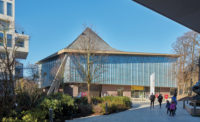13 Lincoln's Inn Fields, London
John Soane's private apartment, on the third floor of his extraordinary London house at 13 Lincoln’s Inn Fields, was a refuge for the architect and his wife, Eliza, within a building that was also his office, salon, and showcase for a vast collection of art and antiquities. But while the house, completed in 1812, has been a site of pilgrimage for generations of architects since its conversion to a museum after Soane’s death in 1837, the apartment has been closed to the public for over 160 years. Its recent reopening, following a comprehensive restoration by Julian Harrap Architects (JHA), is a major milestone in a larger 20-year project to refurbish and improve the museum, and offers visitors an intimate experience of the most personal work by an architect of enduring influence.
After Soane’s death, however, the apartment was adopted by a resident curator, and heavy-handed reorganization and its later use as an office erased its spatial intricacy. Representing such layered history often complicates conservation projects, but here JHA had a ready answer: Soane’s bequest entailed a parliamentary decree that the house should remain as found at his death. The painstaking restoration draws on the evidence of surviving fabric and Soane’s copious documentation, but some mysteries remain. One presents itself as the visitor ascends the winding stone staircase from the celebrated Library and Breakfast Room toward the third floor—the restored Oratory, a narrow antechamber to Soane’s bedroom whose intended purpose is uncertain. Internal stained-glass windows give glimpses into it. The dextrous manipulation of light and views is characteristic, however, and gives a foretaste of the apartment interior, itself a concentrated display of the three-dimensional ingenuity that continues to draw contemporary architects to Soane’s work.
From the entrance, barred by heavy iron gates like a medieval strong room, visitors are led via a dark-wood-paneled lobby into Eliza’s Morning Room, densely hung with paintings and made somewhat strange by the interplay of flat and convex mirrors. A second door leads to the Model Room that replaced her bedroom, whose center is dominated by a large three-tiered display stand.
Each space interconnects with at least two others, and the Model Room opens into the restored Book Passage, a double-height microlibrary in the middle of the plan, and into Soane’s bathroom, where a battery of experts has guided faithful recreations of glass, hand-printed wallpaper, and bronze-infused paint. Original materials that had migrated elsewhere in the building were reinstated after JHA’s careful detective work. Detailed illustrations of each room were a useful “double-check,” says JHA partner Lyall Thow, “but you also have to listen to what the fabric is telling you.”
A slender new screen of wood and glass frames the threshold between the bathroom and Soane’s bedroom, which required significant reconstruction. Visitors are oblivious of the extensive structural work that has restored walls and windows to their proper positions, but the restoration architects’ exactitude has allowed Soane’s possessions, such as a large clock on a deep sill facing the bed, to return neatly to the niches he designed for them. Much of his Regency-period furniture survives and has been restored, although the four-poster bed is a substitute, on loan from his rural retreat, and will be replaced by a replica.
From there, yet more doors lead back to the Book Passage and Oratory. These interstitial spaces form a buffer around his most private sanctuary, lending a sense of seclusion without isolation.
Tucked into a corner of the Oratory is a collection of Eliza’s possessions, including paintings and a vase decorated by her—a small shrine in the midst of a much larger monument to the architect’s singular sensibilities. But although Soane belatedly overwrote the main evidence of his wife’s presence, the care manifested in his design of spaces that provide both privacy and proximity adds new texture to visitors’ understanding of his work, and of the couple’s lives.
Chris Foges is the editor of the London-based journal Architecture Today.
People |
Products
|









Post a comment to this article
Report Abusive Comment